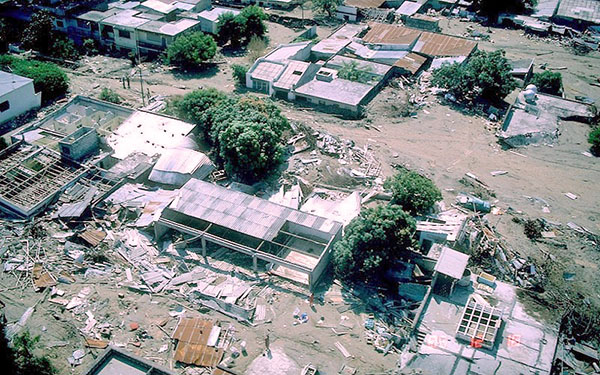The Arme ro tragedy, triggered by the eruption of the Nevado del Ruiz volcano on November 13, 1985, resulted in a devastating catastrophe.
Despite previous warnings, the eruption took the nearby population by surprise, mainly affecting Armero, where more than 20,000 of its 29,000 inhabitants lost their lives. The lahars, flows of mud and debris, descended at a speed of 60 km/h, destroying everything in their path. The tragedy, preventable but exacerbated by a lack of knowledge about the volcano’s history, became the second deadliest volcanic eruption of the 20th century and the fourth deadliest event since the year 1500. Despite subsequent efforts to raise awareness and preparation, Nevado del Ruiz continues to be a threat to the region, reminding us of the importance of prevention in natural disaster situations. In late 1984, geologists observed an increase in seismic activity in Nevado del Ruiz. Fumaroles, sulfur deposition on the summit and La Cifra were noted. More than 20,000 of its 29,000 inhabitants. Victims in other towns, particularly in the municipalities of Chinchiná and Villaría, increased the death toll to more than. 23,000. Alleged negligence Concerns about the alleged negligence of local authorities in the face of the volcano threat led to strong controversy. The mayor of Armero, Ramón Rodríguez, and several local officials tried in vain to draw the attention of the Colombian government to the danger posed by the volcano. For months, Rodríguez made calls to various authorities, including several congressmen, the then governor of Tolima, Eduardo Alzate García, and the Minister of Legacy. Nevado del Ruiz continues to be a serious threat to nearby towns due to the possibility of eruptions. of low volume that can destabilize glaciers and generate lahars. Although part of the glacier has retreated, 10% of its ice could still cause lahars of up to 200 million cubic meters, similar to those that devastated Armero in 1985. Nearly 500,000 people in the valleys of the Combeima, Chinchiná, Coello rivers -Toche and Gualí are at risk, with 100,000 at high risk.
The towns of Honda, Mariquita, Ambalema. Santa Isabel, Lebanon, Mariquita, Guayabal, Chinchiná and Armero. phreatic eruptions, warning of a possible eruption. Activity declined in October, but analysis of gas and terrain samples indicated a high risk of lahars. A report dated October 22 warned authorities, suggesting preparedness measures. Volcanic activity increased in November, with sulfur-rich gases and magma seeping in. However, the map had little distribution and did not reach many at-risk residents. The nearby springs. Intensive degassing created high pressure, culminating in an explosive eruption in 1985. In September 1985, with earthquakes and phreatic eruptions, local authorities planned evacuations. A risk map was drawn up in October, highlighting dangers in Murillo. Civil Defense and the Red Cross attempted to coordinate evacuations, but electrical problems and a storm hampered efforts. Local authorities instructed the population to return to their homes around 7:00 p.m. On the day of the eruption, ash columns alerted authorities, but the lack of systematic alerts and confusion led to insufficient evacuation. The eruption occurred at 9:45 p.m., leaving Armero vulnerable.
NUMBER: More than 20,000 of its 29,000 inhabitants. Victims in other towns, particularly in the municipalities of Chinchiná and Villaría, increased the death toll to more than. 23,000
FEATURED: Improvised triage stations are established in Lérida, Guayabal and Mari Quita. The United States and other nations invested in aid and supplies, including mobile hospitals, tents and medical equipment. However, mud and destroyed roads hampered efforts, delaying rescues and contributing to high mortality among the injured. About a week later, rescue efforts came to an end, with an official toll of 22,540 dead, 3,300 missing, 4,000 injured and 20,000 homeless. Looting increased, and survivors faced risks of disease. The eruption stood out as an example of psychiatric recovery after natural disasters, revealing mental health problems among survivors.
Alleged negligence Concerns about the alleged negligence of local authorities in the face of the volcano threat led to strong controversy. The mayor of Armero, Ramón Rodríguez, and several local officials tried in vain to draw the attention of the Colombian government to the danger posed by the volcano. For months, Rodríguez made calls to various authorities, including several congressmen, the then governor of Tolima, Eduardo Alzate García, and the mines minister Iván Duque Es cobar. Rodriguez called the volcano a “time bomb” and told reporters that he believed an eruption would breach a natural dam located upstream, leading to flooding. Despite his insistence, only two congressmen, Hernando Arango Monedero and Guillermo Alfonso Jara Millo, paid interest to the situation, carrying out debates on the issue in Congress and Iván Duque is cobar. Rodriguez called the volcano a “time bomb” and told reporters that he believed an eruption would breach a natural dam located upstream, leading to flooding. Despite his insistence, only two congressmen, Hernan warned the government about the possibility of a tragedy, a possibility that was also pointed out by Ingeominas.
You may be interested in: I Regional Meeting of Literature Teachers stands out at FilSMar
